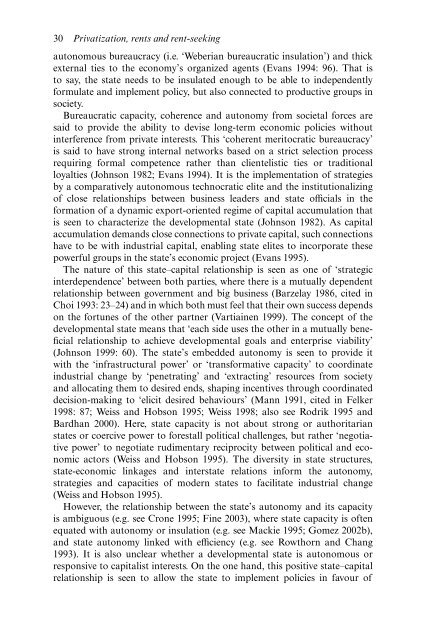PRIVATIZATION Privatization in Malaysia, Regulation, rent-seeking and policy failure
PRIVATIZATION Privatization in Malaysia, Regulation, rent-seeking and policy failure
PRIVATIZATION Privatization in Malaysia, Regulation, rent-seeking and policy failure
Create successful ePaper yourself
Turn your PDF publications into a flip-book with our unique Google optimized e-Paper software.
30 <strong>Privatization</strong>, <strong>rent</strong>s <strong>and</strong> <strong>rent</strong>-seek<strong>in</strong>gautonomous bureaucracy (i.e. ‘Weberian bureaucratic <strong>in</strong>sulation’) <strong>and</strong> thickexternal ties to the economy’s organized agents (Evans 1994: 96). That isto say, the state needs to be <strong>in</strong>sulated enough to be able to <strong>in</strong>dependentlyformulate <strong>and</strong> implement <strong>policy</strong>, but also connected to productive groups <strong>in</strong>society.Bureaucratic capacity, coherence <strong>and</strong> autonomy from societal forces aresaid to provide the ability to devise long-term economic policies without<strong>in</strong>terference from private <strong>in</strong>terests. This ‘cohe<strong>rent</strong> meritocratic bureaucracy’is said to have strong <strong>in</strong>ternal networks based on a strict selection processrequir<strong>in</strong>g formal competence rather than clientelistic ties or traditionalloyalties (Johnson 1982; Evans 1994). It is the implementation of strategiesby a comparatively autonomous technocratic elite <strong>and</strong> the <strong>in</strong>stitutionaliz<strong>in</strong>gof close relationships between bus<strong>in</strong>ess leaders <strong>and</strong> state officials <strong>in</strong> theformation of a dynamic export-oriented regime of capital accumulation thatis seen to characterize the developmental state (Johnson 1982). As capitalaccumulation dem<strong>and</strong>s close connections to private capital, such connectionshave to be with <strong>in</strong>dustrial capital, enabl<strong>in</strong>g state elites to <strong>in</strong>corporate thesepowerful groups <strong>in</strong> the state’s economic project (Evans 1995).The nature of this state–capital relationship is seen as one of ‘strategic<strong>in</strong>terdependence’ between both parties, where there is a mutually dependentrelationship between government <strong>and</strong> big bus<strong>in</strong>ess (Barzelay 1986, cited <strong>in</strong>Choi 1993: 23–24) <strong>and</strong> <strong>in</strong> which both must feel that their own success dependson the fortunes of the other partner (Vartia<strong>in</strong>en 1999). The concept of thedevelopmental state means that ‘each side uses the other <strong>in</strong> a mutually beneficialrelationship to achieve developmental goals <strong>and</strong> enterprise viability’(Johnson 1999: 60). The state’s embedded autonomy is seen to provide itwith the ‘<strong>in</strong>frastructural power’ or ‘transformative capacity’ to coord<strong>in</strong>ate<strong>in</strong>dustrial change by ‘penetrat<strong>in</strong>g’ <strong>and</strong> ‘extract<strong>in</strong>g’ resources from society<strong>and</strong> allocat<strong>in</strong>g them to desired ends, shap<strong>in</strong>g <strong>in</strong>centives through coord<strong>in</strong>ateddecision-mak<strong>in</strong>g to ‘elicit desired behaviours’ (Mann 1991, cited <strong>in</strong> Felker1998: 87; Weiss <strong>and</strong> Hobson 1995; Weiss 1998; also see Rodrik 1995 <strong>and</strong>Bardhan 2000). Here, state capacity is not about strong or authoritarianstates or coercive power to forestall political challenges, but rather ‘negotiativepower’ to negotiate rudimentary reciprocity between political <strong>and</strong> economicactors (Weiss <strong>and</strong> Hobson 1995). The diversity <strong>in</strong> state structures,state-economic l<strong>in</strong>kages <strong>and</strong> <strong>in</strong>terstate relations <strong>in</strong>form the autonomy,strategies <strong>and</strong> capacities of modern states to facilitate <strong>in</strong>dustrial change(Weiss <strong>and</strong> Hobson 1995).However, the relationship between the state’s autonomy <strong>and</strong> its capacityis ambiguous (e.g. see Crone 1995; F<strong>in</strong>e 2003), where state capacity is oftenequated with autonomy or <strong>in</strong>sulation (e.g. see Mackie 1995; Gomez 2002b),<strong>and</strong> state autonomy l<strong>in</strong>ked with efficiency (e.g. see Rowthorn <strong>and</strong> Chang1993). It is also unclear whether a developmental state is autonomous orresponsive to capitalist <strong>in</strong>terests. On the one h<strong>and</strong>, this positive state–capitalrelationship is seen to allow the state to implement policies <strong>in</strong> favour of


